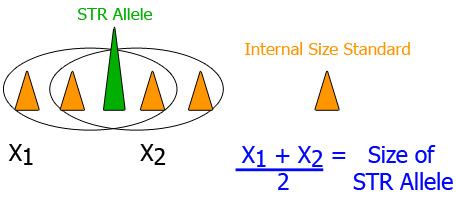Archival Notice
This is an archive page that is no longer being updated. It may contain outdated information and links may no longer function as originally intended.
Home | Glossary | Resources | Help | Contact Us | Course Map
The analyst selects one of four possible size calling methods (in the analysis parameters) utilized by GeneScan®:
- Local Southern
- 2nd (or 3rd) Order Least Squares
- Cubic Spline
- Global Southern method
The Local Southern method for size calling is the most commonly used algorithm in forensic DNA analysis. It determines the sizes of fragments by using the reciprocal relationship between fragment length and mobility. The unknown fragment is surrounded by two known sized fragments above and one below then two below and one above. The results are averaged and the size of the allele is determined.
For a review of size calling methods 2-4 listed above, reference the GeneMapper® ID software version 3.1 User's Guide.02
Below is a visual representation of the sizing process of the Local Southern method.
In variable-temperature environments, some studies have found that the Global Southern method (rather than the Local Southern method), may provide better sizing precision.03, 04
One important issue concerning the sizing of AmpFℓSTR® GS500 size standards (ROX or LIZ) is the de-labeling of the 250 base pair fragment. At a minimum, the 250 fragment should not be labeled.04
Read more about delabeling in this course.
The size calling method is one component of the overall parameter settings that are configured prior to analyzing data.
Additional Online Courses
- What Every First Responding Officer Should Know About DNA Evidence
- Collecting DNA Evidence at Property Crime Scenes
- DNA – A Prosecutor’s Practice Notebook
- Crime Scene and DNA Basics
- Laboratory Safety Programs
- DNA Amplification
- Population Genetics and Statistics
- Non-STR DNA Markers: SNPs, Y-STRs, LCN and mtDNA
- Firearms Examiner Training
- Forensic DNA Education for Law Enforcement Decisionmakers
- What Every Investigator and Evidence Technician Should Know About DNA Evidence
- Principles of Forensic DNA for Officers of the Court
- Law 101: Legal Guide for the Forensic Expert
- Laboratory Orientation and Testing of Body Fluids and Tissues
- DNA Extraction and Quantitation
- STR Data Analysis and Interpretation
- Communication Skills, Report Writing, and Courtroom Testimony
- Español for Law Enforcement
- Amplified DNA Product Separation for Forensic Analysts


